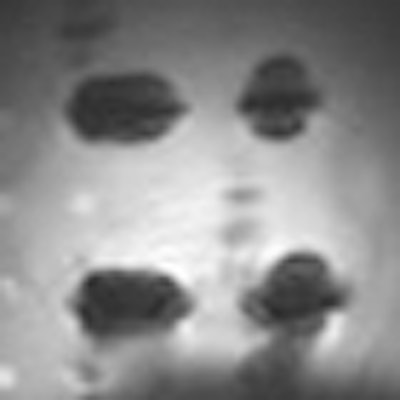
SAN FRANCISCO - Most patients with bullets in their bodies can be safely scanned with MRI, but not those harboring armor-piercing steel bullets, according to a study presented at this week's American Academy of Orthopaedic Surgeons (AAOS) meeting.
Patients lucky enough to survive the impact of a gunshot wound are at risk from retained ferromagnetic bullets at MRI, especially in the higher-field-strength 3- and 7-tesla machines that are becoming increasingly common in medical facilities.
Armor-piercing bullets with stainless steel cores and steel shotgun pellets are not safe in an MRI environment, concluded Dr. Russell Dedini and colleagues from the University of California, San Francisco (UCSF), and two other institutions. The group looked at 32 different bullets that were embedded in phantoms and scanned in three kinds of scanners, finding only one that "twisted and moved quite a bit," according to Dedini.
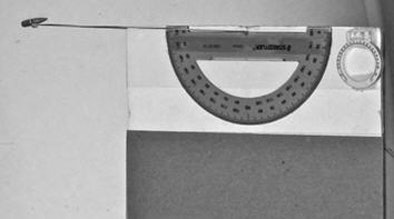 |
| Deflection angle test performed on the armor-piercing bullet (No. 32) containing a steel core. The deflection angle is 90°, indicating the presence of substantial translational attraction. All images courtesy of Dr. Russell Dedini. |
It's not as though MRI is about to become the first-line imaging modality for patients with gunshot wounds, Dedini explained in an interview with AuntMinnie.com. MRI scans are used in acute trauma, of course, "but I would say it's more common to do an MRI on somebody with a retained bullet that's been there for a long time," he said.
Acute trauma patients would generally get a CT scan to determine stability or to look for bone fragments if physicians are considering fusion. However, they would need to know that no ferromagnetic objects were present before considering an MRI.
"Anytime someone has an implant of any type, and a bullet would be considered a type of implant, you need to determine what the safety profile is of that before you put them in the scanner," Dedini said. ASTM International (formerly the American Society for Testing of Materials) "has strict protocols, and you need to determine whether [implants] move, whether they heat, and what kind of artifact they generate" at MRI, he added.
The study was performed by Dedini and his UCSF colleagues Dr. Robert McClellan and Dr. Murat Pekmezci, in cooperation wtih Dr. Frank Shellock from the University of Southern California's Institute for Magnetic Resonance Safety, Education, and Research, and Alexandra Karacozoff from Loyola Marymount University, both in Los Angeles.
Their study examined the safety of retained bullets in MRI scanners. Earlier research has suggested that bullets lodged in patients are generally safe in 1.5-tesla MRI scanners, but it is unknown if they are safe in 3- and 7-tesla scanners.
It is well-known that metal implants can pose risks to soft tissue and to vascular and neural structures due to movement and heating effects in the MRI environment, Dedini said in his talk. The handful of studies looking at the issue of bullets and retained ballistics are older and would be considered unpublishable today due to methodological weaknesses, he said.
"We hypothesized that commonly available bullets do not cause clinically relevant heat, movement, or artifact during MRI at stronger field strengths," Dedini said.
 |
| Above, experimental setup for evaluating MR-imaging related artifacts at 3-tesla includes five representative bullets placed on a plastic frame. The top four are conventional bullets, and the bottom bullet is the armor-piercing bullet containing a steel core. Below, MR-imaging induced artifact observed for the five bullets reveals excessive signal void associated with the armor-piercing bullet (No. 32) at the bottom of the image. |
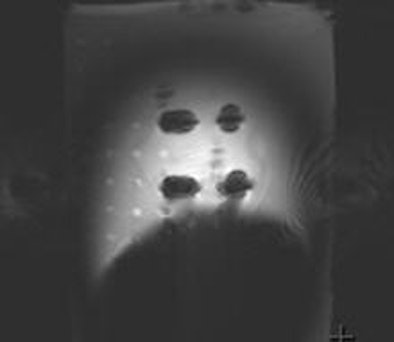 |
The study team scanned 32 commercially available bullets and seven shotgun pellets provided by the San Francisco Police Department, typically composed of a lead core with copper coatings or jackets. One bullet in the sample was an armor-piercing bullet with a hardened steel core, a copper-coated jacket, and a lead tip. Two of the shotgun pellets also contained steel.
All of the bullets were scanned at 1.5-, 3-, and 7-tesla MRI, and were tested for the following parameters:
- Ex vivo translational force (calculated in dynes using a previously described deflection angle technique) for bullets attached to a string and placed in a 1.5-tesla scanner at the point of greatest magnetic field.
- Rotational force using a scale of 0 to 4 (4 being greatest) describing the force and speed with which each sample aligned with its long axis within the static magnetic field. For this experiment, each bullet was placed on a grid device and allowed to freely rotate after being placed in the center of the MRI bore.
- Radiofrequency-induced heating was measured in five representative bullets using a custom temperature probe and fast spin-echo T2-weighted sequences. This was designed to test the worst-case-scenario exposure to the U.S. Food and Drug Administration-approved limit of radiofrequency-induced excitation (3.2 watts/kg specific absorption rate) at 3-tesla MRI for 15 minutes, reporting the highest temperature achieved.
- Artifact was measured by placing the bullets in a gel-filled head phantom dosed with gadolinium. Gradient echo sequences were chosen to approximate a worst-case scenario.
According to the results, "nonsteel-containing items showed no magnetic field effects; that is, they did not move," Dedini said. However, "all items containing steel deflected 90°," and the armor-piercing bullet moved the most, he said. Displaying torque that measured 4+ on the scale, this bullet's translational force exceeded safe levels at all three magnetic field strengths.
The highest temperature change was 1.7° C compared to background, leading the researchers to conclude that "MRI-induced heating is not significant regardless of bullet composition."
As for image artifact, all of the bullets created some, but in this category, again, the steel-core bullet was the worst example, generating 100 times greater signal loss than the bullets that did not contain steel.
Regular commercially available bullets manufactured in the U.S are safe in scanners up to 7-tesla, the authors concluded. In contrast, armor-piercing bullets with steel cores and stainless steel shotgun pellets "should be considered unsafe due to movement," Dedini said.
MRI should be avoided when bullets known to contain steel are located very near to critical anatomic structures, the authors wrote in an accompanying abstract. The findings emphasize the importance of obtaining forensic information on retained projectiles wherever possible, they said.
"Ultimately, our study doesn't say whether [MRI] is safe or not" for patients with retained bullets, Dedini told AuntMinnie.com. "It supports the use of it and the risk-benefit ratio leans more toward the benefits side. But unless you know exactly what's in there you cannot say with 100% confidence that it's safe. But if you do know that it's just lead or copper, those bullets are apparently not posing any risk."



.fFmgij6Hin.png?auto=compress%2Cformat&fit=crop&h=100&q=70&w=100)

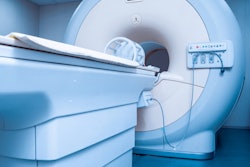

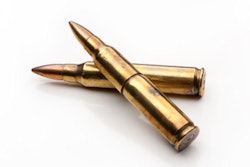
.fFmgij6Hin.png?auto=compress%2Cformat&fit=crop&h=167&q=70&w=250)











